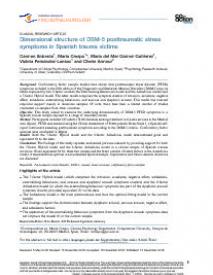Dimensional structure of DSM-5 posttraumatic stress symptoms in Spanish trauma victims
Background
Confirmatory factor analytic studies have shown that posttraumatic stress disorder (PTSD) symptoms included in the fifth edition of the Diagnostic and Statistical Manual Disorders (DSM-5) may be better explained by two 6-factor models (the Externalizing Behaviours model and the Anhedonia model) and a 7-factor Hybrid model. The latter model comprises the symptom clusters of intrusion, avoidance, negative affect, anhedonia, externalizing behaviours, and anxious and dysphoric arousal. This model has received empirical support mainly in American samples. Of note, there have been a limited number of studies conducted on samples from other countries.
Objective
This study aimed to examine the underlying dimensionality of DSM-5 PTSD symptoms in a Spanish clinical sample exposed to a range of traumatic events.
Method
Participants included 165 adults (78.8% females) seeking treatment in trauma services in the Madrid area (Spain). PTSD was assessed using the Global Assessment of Posttraumatic Stress Scale 5, a Spanish self-report instrument assessing posttraumatic symptoms according to the DSM-5 criteria. Confirmatory factor analyses were conducted in Mplus.
Results
Both the 7-factor Hybrid model and the 6-factor Anhedonia model demonstrated good and equivalent fit to the data.
Conclusions
The findings of this study replicate and extend previous research by providing support for both the 7-factor Hybrid model and the 6-factor Anhedonia model in a clinical sample of Spanish trauma survivors. Given equivalent fit for these two models and the fewer number of latent factors in the Anhedonia model, it was selected as optimal in a traumatized Spanish sample. Implications and future research directions are discussed.
Highlights of the article
•The 7-factor Hybrid model (which comprises the intrusion, avoidance, negative affect, anhedonia, externalizing behaviours, and anxious and dysphoric arousal symptoms clusters) and the 6-factor Anhedonia model (in which the externalizing behaviour symptoms are part of the dysphoric arousal symptom cluster) provided equivalent fit to the data.
•The Anhedonia model is the most parsimonious and thus the optimal-fitting model in the current sample.
•The findings support the distinctiveness between dysphoric arousal, anxious arousal, negative affect, and anhedonia factors.
•The separation of the externalizing behaviour symptoms from the dysphoric arousal symptoms does not improve the model fit in the current sample.
In: European journal of psychotraumatology, ISSN 2000-8066 | 7 | 32078
https://dx.doi.org/10.3402%2Fejpt.v7.32078


